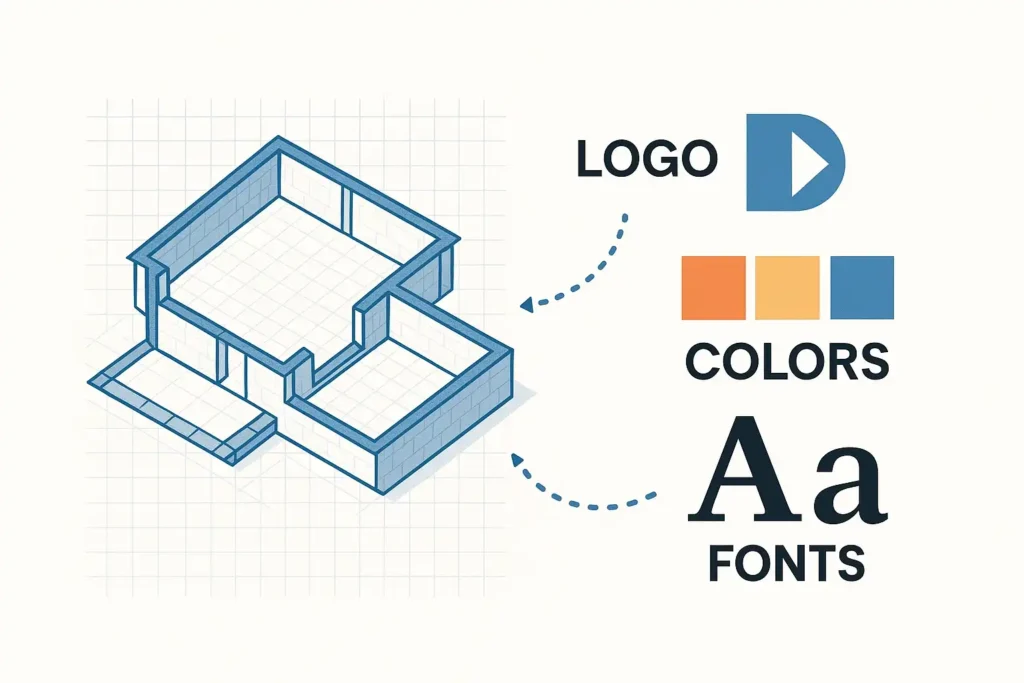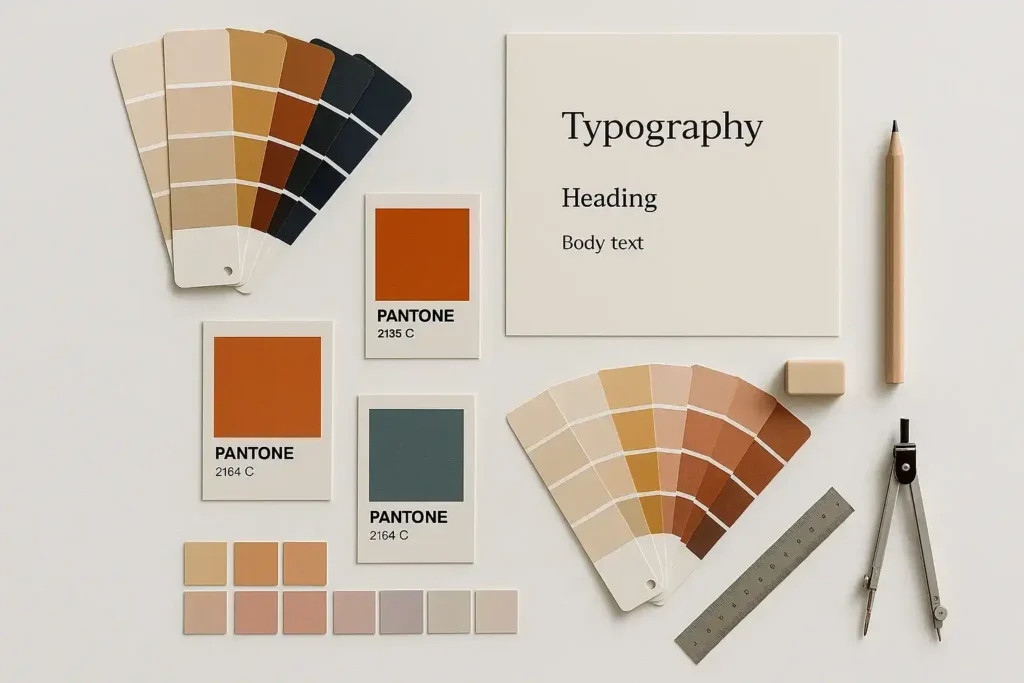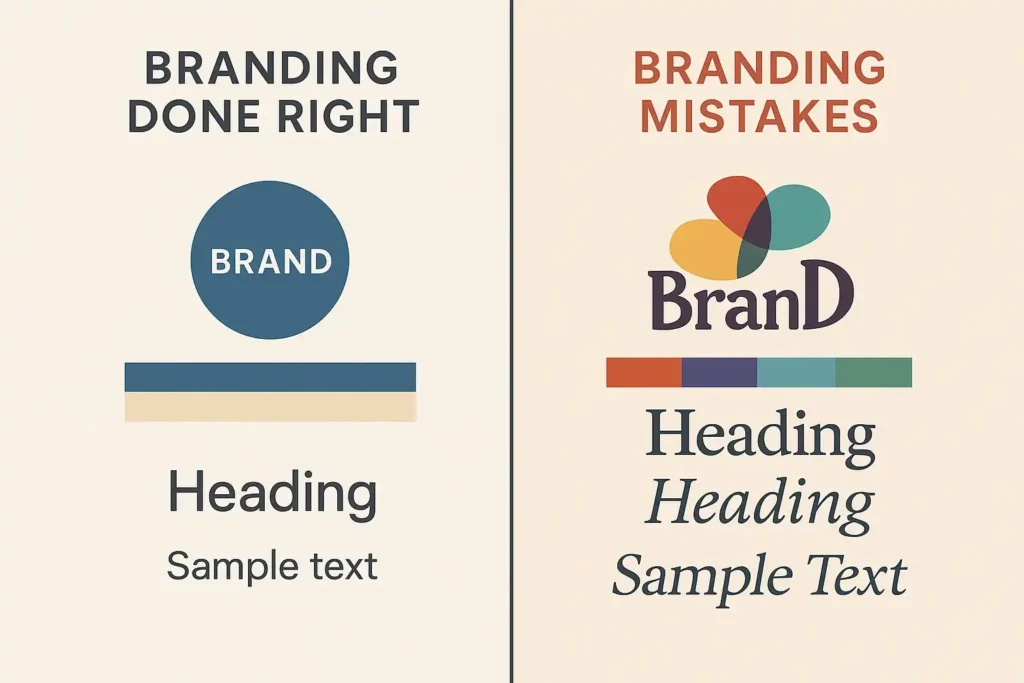Many new business owners follow the same pattern constantly: they jump straight into designing a logo and choosing colors without laying the strategic groundwork first. This approach creates generic brands that struggle to connect with customers and stand out from the competition.
Here’s what’s interesting—a 2025 Capital One Shopping report shows that 79% of consumers are more loyal to brands that communicate consistently across all departments. Yet most beginners focus entirely on visual design while neglecting the strategic foundations that actually drive business results. Successful startups understand this—they prioritize building a compelling brand story and establishing trust through clear mission and values rather than obsessing over visual elements in the early stages.
Whether you’re launching your first venture or looking to rebrand, I want to walk you through beginner branding tips that actually work. We’ll cover everything from defining your target audience to creating budget-friendly visual assets, and I promise to keep both your wallet and your brand strategy happy.
Key Takeaways
Before we dive into the details, here are the essential principles I’ve seen separate successful branding efforts from failed attempts:
- Define your target audience before making any design decisions—this shapes every branding choice from colors to messaging
- Start with brand foundations (mission, values, voice) before creating visual elements like logos
- Consistency across all touchpoints builds trust and brand recognition faster than sporadic efforts
- Your brand is what customers say about you when you’re not present—manage it intentionally through every interaction
- Use free tools like Canva, Google Fonts, and Shopify’s generators when starting with limited budget
- Document everything in a simple brand style guide to maintain consistency as you grow

Start With Your Foundation, Not Your Logo
The biggest misconception I encounter is that brand identity begins with a logo design. In reality, your brand strategy must come first. Think of branding like building a house—you wouldn’t start with the paint color before laying the foundation, and the same principle applies here.
Define Your Target Audience First
Your target audience should influence every single branding decision you make. Instead of creating vague “ideal customer” profiles, I recommend developing detailed customer personas that feel like real people.
Include these elements:
- Demographics: Age, gender, income, education level, location
- Psychographics: Values, interests, lifestyle preferences, aspirations
- Pain points: What problems does your product or service solve for them?
- Communication preferences: Do they prefer email, social media, or phone calls?
- Purchase motivators: What drives their buying decisions?
Research consistently shows that buyer personas improve targeting, engagement, and ROI. Take the time to survey potential customers, analyze your competition’s audiences, and create personas that feel like people you could have coffee with rather than demographic statistics.
Develop Your Brand Mission and Values
Your mission statement answers “why do we exist?” while your brand values define “how do we behave?” These elements become wonderful filters for all future branding decisions and help you build something that stands for something meaningful.
Write a clear one-sentence mission statement that captures your purpose. I love Patagonia’s example: “We’re in business to save our home planet.” It immediately communicates their environmental focus and guides everything from product development to marketing campaigns.
Your values should be specific and actionable. Instead of generic terms like “quality” or “excellence,” consider values like “transparency in all communications” or “prioritizing customer education over sales pressure.” These give you real guidance when making decisions.
Establish Your Unique Value Proposition
Your unique value proposition (UVP) defines what makes you irreplaceable in your target market. It’s not just what you sell, but why customers should care about your specific solution.
I find this simple formula really helpful: “We help [target audience] achieve [desired outcome] by [unique approach/method].”
Research your competition to identify gaps in the market where your brand can own unique territory. Your UVP should be clear enough that a potential customer understands your value within seconds of encountering your brand—and that’s not an exaggeration.
Choose Your Brand Personality
Your brand personality describes the human traits your company exhibits. Are you professional and authoritative? Friendly and approachable? Playful and creative? Bold and disruptive?
Academic research consistently links brand personality—especially sincerity—to higher brand trust. I recommend choosing 3-4 personality traits that align with both your target audience’s preferences and your company’s natural communication style. This authenticity really matters.
This foundational work might seem less exciting than designing a logo, but it’s the powerful tool that will guide every other branding decision and ensure your efforts actually connect with customers.
Research Your Market and Competition
Understanding your competitive landscape helps you create a cohesive brand that stands out rather than blends in. I’ve found that effective market research helps identify opportunities while preventing you from accidentally copying competitors.
Analyze Your Direct Competition
Start by identifying 5-10 direct competitors and systematically document their branding choices. I like to track:
- Visual elements: Color palettes (note specific HEX codes), typography choices, logo styles
- Brand voice: Tone, vocabulary, messaging themes
- Online presence: Website design, social media profiles, content strategy
- Customer touchpoints: How they interact with customers at different stages
Create a simple spreadsheet to track this information. Look for patterns—are most competitors using similar blue color schemes? Do they all adopt formal, corporate language? These patterns represent wonderful opportunities for your brand to differentiate.
Study Adjacent Industries
Some of the most innovative branding ideas come from looking outside your immediate competition. If you’re launching a fitness app, look at how successful meal delivery services, meditation apps, or wellness brands connect with health-conscious consumers.
This approach helps you avoid the echo chamber effect where everyone in an industry starts looking and sounding identical—and trust me, this happens more often than you’d think.
Use Research Tools
Google Trends provides immediate insight into search patterns and consumer interest over time. For example, Google searches for sustainable products rose about 130% globally between 2017 and 2022, signaling a major shift in consumer values that smart brands have incorporated into their messaging.
Even 20-50 survey responses can reveal valuable insights about preferences, pain points, and communication styles that resonate with your target market. Tools like Typeform or Google Forms make this process really simple.
Develop Your Brand Voice and Messaging
Your brand voice is how your company “speaks” across all communications. It encompasses tone, vocabulary, and personality, creating the verbal component of your brand identity that customers experience every time they interact with your business.
Write Your Brand Story
Your brand story isn’t your company history—it’s the compelling narrative that helps customers understand why your business exists and why they should care.
Structure your brand story in 2-3 paragraphs covering:
- The problem or opportunity that inspired your business
- Your unique approach to solving that problem
- The vision of the world you’re helping create
Your brand story should feel authentic and human. Avoid corporate jargon in favor of language your target audience actually uses—they’ll appreciate the authenticity.
Create a Brand Voice Chart
I always recommend defining 3-4 key personality traits for your brand voice, then providing specific examples of how each trait manifests. Here’s a format that works well:
| Voice Trait | We Do | We Don’t |
|---|---|---|
| Knowledgeable | Share specific, actionable advice | Use jargon without explanation |
| Approachable | Write in conversational tone | Sound overly formal or intimidating |
| Encouraging | Focus on possibilities and growth | Shame or pressure customers |
This chart becomes a reference tool for anyone creating content for your brand, ensuring consistency even as your team grows.
Choose Your Visual Identity Elements
Once your strategic foundation is solid, you can begin developing the visual components. Remember, these visual elements should support and amplify your brand strategy, not drive it.

Select Your Brand Colors
Choose 2-3 primary colors and 1-2 accent or neutral colors for your palette. Color psychology really does play a role—blue conveys trust and reliability (which is why it’s popular in finance), while green signals health and environmental consciousness.
Document your colors in multiple formats:
- HEX codes for digital use (#FF5733)
- RGB values for screen displays
- CMYK values for print materials
Limit yourself to this core palette across all marketing materials. Too many colors dilute your brand recognition and create visual chaos that confuses customers.
Choose Typography
Select 1-2 fonts maximum for your brand. Google Fonts offers an excellent free library of professional typefaces that work beautifully across all platforms.
Use one font for headers and another for body text, or choose a versatile font family that includes multiple weights (light, regular, bold) for different uses. Beyond two font families, your brand starts looking inconsistent and unprofessional—and that’s something we definitely want to avoid.
Apply Your Brand Consistently Across Channels
Consistency transforms individual brand elements into a cohesive brand experience that customers recognize and trust. Multiple sources confirm that consistent brand presentation across all platforms can increase revenue by up to 23%. The Lucidpress “State of Brand Consistency” report found that 25.7% of respondents noted brand consistency substantially contributed to overall revenue growth.
The key is treating every customer interaction as a branding opportunity, ensuring each experience reinforces your brand identity and values. This includes everything from your email signature to your invoice template—they all matter.
Remember, 83% of customers feel more loyal to brands that respond and resolve their complaints consistently. This reinforces how important it is to maintain your brand voice and values across all customer touchpoints.

Common Branding Mistakes to Avoid
Learning from others’ mistakes can save you significant time, money, and frustration. Here are the most frequent errors I see derailing beginner branding efforts:
Copying Instead of Inspiring It’s natural to admire successful brands, but directly copying their approach dilutes your uniqueness and can create legal issues. Instead, study what makes admired brands successful and adapt those principles to your unique context and audience.
Over-Designing Your Brand Using more than 2 fonts or 4 colors creates visual chaos rather than professional polish. The most memorable brands often use simple, limited palettes and typography systems. Think about Apple or Nike—their strength comes from simplicity and consistency, not complexity.
Changing Too Frequently Brand recognition requires sustained exposure over time. Changing your logo, colors, or messaging every few months prevents customers from forming strong associations with your brand. Top brands maintain visual stability for 5-7 years unless their entire business strategy pivots.
Budget-Friendly Branding Tools for Beginners
Building a professional brand doesn’t require a massive budget if you leverage the right tools:
Canva ($12.99/month for Pro, free tier available) provides access to beautiful templates and design tools. I particularly love their brand kit functionality, which helps maintain consistency across all your designs.
Google Fonts offers free access to over 1,700 font families with easy download and web embedding options. The quality matches premium font services without the cost.
Coolors.co (free core features) generates harmonious color palettes and helps beginners create professional-looking color schemes without needing color theory knowledge.
Most of these tools offer free tiers sufficient for getting started, with affordable upgrade paths as your business grows.
Final Thoughts
Building a successful brand doesn’t happen overnight, but it doesn’t require a massive budget or design expertise either. The most important factor is starting with strategic thinking rather than jumping directly into visual design.
Remember that your brand is ultimately what customers say about you when you’re not in the room. Every interaction contributes to that perception. Focus on consistency, authenticity, and serving your target audience’s real needs.
Start with your foundation, stay consistent in your application, and remember that every great brand began exactly where you are now—with a vision and the commitment to bring it to life. You’ve got this, and I’m excited to see what you create.